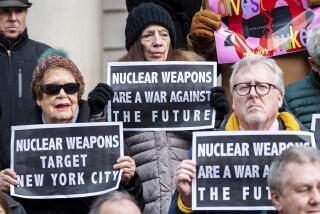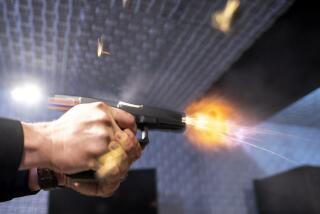COLUMN ONE : Not So Deadly Weapons : The U.S. is trying to figure out how to sting, stun and strand enemy forces without killing them. The push to develop ‘non-lethal’ devices is prompted by America’s increasing role as a peacekeeper.
- Share via
WASHINGTON — A powerful laser device mounted under an M1A2 tank sets off a huge blinding flash that temporarily impairs the vision of enemy troops, leaving them vulnerable to capture.
An acoustic generator sends out high-frequency sound waves that disorient opposing forces--and, in some cases, even injure them.
A special forces unit clandestinely sprays enemy armored vehicles with special combustion-inhibitors that stifle their engines--immobilizing an entire column.
If all that sounds like the stuff of a James Bond movie, then re-check your sights. The technology is part of the new, modern-day military. And some of it may well be used the next time U.S. forces intervene abroad.
Such flashy concepts are part of a growing push by the Pentagon to develop “non-lethal” weapons--devices that can enable U.S. forces to disrupt enemy communications and disable equipment without actually killing anyone.
With U.S. forces increasingly active in peacekeeping operations--and public tolerance for killing shrinking steadily--strategists are looking for ways to disarm rather than kill enemy forces and to reduce the risk of accidental injury to civilians.
Proponents of the new technology argue that if U.S. forces in Mogadishu had had non-lethal weapons, they could have disarmed machine gun-carrying youths and dispersed hostile crowds without killing hundreds of Somalis--or producing such an angry backlash from clan members.
Long under wraps as part of the Army’s super-secret weapons program, non-lethal weaponry is gaining increasing attention as an alternative to the use of massive force displayed by the United States in the Persian Gulf War in 1991.
Army weapons laboratories are building prototypes of several of these weapons. The service is moving to write special doctrine and training manuals. And defense experts say officials have begun testing the weapons in simulated war games.
“We are planning on modeling this on a battle-lab scenario,” says Col. Thomas Sinclair, commander of the Army’s Close-Combat Armaments Center at Picatinny Arsenal in New Jersey. “There’s a lot of technology out there. We’re trying to see what people want.”
The acoustics and combustion-inhibitors are not the only exotic gadgets in the scientists’ labs. They also are experimenting with stun guns that shoot out electrified nylon “sting-nets,” which can trap an enemy and shock him if he tries to escape.
The researchers also have used polymers to make roads, railroad tracks and runways either extra slippery or super sticky; sprayed chemicals on aircraft wings to make them extra brittle, and used super caustic acids to weaken bridges and tunnels.
They have employed high-powered microwaves to “melt down” electronic systems on conventional weapons. And they have used lasers to destroy the targeting optics on tanks, rendering the behemoths almost useless.
John Alexander, a special technologies expert at Los Alamos National Laboratory in New Mexico, argues that non-lethal weapons are particularly suited to post-Cold War missions, such as international peacekeeping, where conventional weapons sometimes prove excessive.
American troops in Mogadishu often were forced to deal with teen-agers wielding automatic weapons and with crowds of hostile Somalis mingled with heavily armed militiamen. Use of conventional bombs, artillery and mortars would risk killing civilians.
Harvey Sapolsky, a political scientist at the Massachusetts Institute of Technology, says the increased use of non-lethal weapons also could help cope with another reality of post-Cold War military actions--adverse public reaction to any sizable number of casualties.
Sapolsky points out that public support for the U.S. intervention in Somalia began to sour quickly almost as soon as the first deaths--both American and Somali--were reported, and when U.S. troops inadvertently killed women and children in one episode with helicopter-fired missiles.
Americans are “losing their tolerance” for death and injury, “even for killing enemies,” he says.
But even advocates of non-lethal weaponry caution that the concept still has serious limits, and is useful more for isolated strikes in specific situations than as any sort of substitute for conventional arms.
“They’re mainly ancillary weapons, used to augment conventional weapons in order to give a commander additional options,” says retired Army Lt. Gen. Richard Trefry, an expert on non-lethal devices.
“No one ever envisaged that these things would take the place of regular weapons,” he adds.
Moreover, Milton Finger, director of the advanced conventional weapons program at Lawrence Livermore National Laboratory in California, concedes that the use of non-lethal weaponry “puts some new demands on us” that conventional weapons do not require.
For one thing, he says, because non-lethal weapons must be employed at close range, commanders who use such weapons must have more accurate intelligence, targeting and delivery systems than they do under conventional systems.
There also is the question--still undecided, under traditional Army doctrine--of what to do after the non-lethal weapon has accomplished its mission: Once you’ve stopped a column of armored vehicles with sticky-glue, do you then shoot the people inside?
Some non-lethal weapons have their own built-in limitations. Spreading a super-sticky polymer on a highway may stop the flow of an enemy armored column, but it also could leave the road useless when U.S. forces might need it. No solution is yet in hand.
And finally, there is always the worry that enemy forces will be able to develop countermeasures that would render a non-lethal weapon ineffective. Conventional U.S. weapons are so heavily computer-controlled they are especially vulnerable to computer viruses.
Myron L. Wolbarsht, a Duke University ophthalmologist who has written a book, “Laser Weapons: The Dawn of a New Military Age,” on the new laser technology, warns that some supposedly non-lethal weapons are not quite as harmless as they might seem.
Wolbarsht points out that a laser beam designed to destroy the optics system of a tank could easily blind the tank operator permanently. And microwave weapons used to disrupt an opponent’s communications network could “fry” any soldiers hit by them as well.
There also are taboos--through the Geneva Convention and other international treaties on the conduct of war--that restrict military forces. Firing pepper gas, while technically non-lethal, could bring charges that U.S. troops were using chemical warfare.
Ironically, however, America’s state and local police forces have no such constraints, and are a potential market for non-lethal weapons, which proponents say could be useful in situations such as the standoff with Branch Davidian cult members near Waco, Tex., last April.
The Army already is working with the Coast Guard and the National Institute of Justice to promote sting-nets and other such exotic weapons as technology that could be made available to SWAT teams and other law enforcement units.
And researchers are pushing to complete a report that outlines the scope and prospects for such weapons, in hopes of conducting more test simulations in the spring.
So far, the actual use of non-lethal weapons has been quite limited. U.S. special forces units are believed to have experimented with a few of the techniques being discussed, but military officers say there has been no widespread use of them by U.S. forces in battle.
But with law enforcement authorities interested in acquiring non-lethal weapons, Army officials have begun touting the new devices as so-called dual-use technology that could be made by private contractors in both military and civilian versions.
Although such weapons are unlikely to yield hundreds of billions of dollars in defense contracts, as aircraft and submarines now provide, experts say they could provide jobs for smaller firms. So far, the need for secrecy has limited the number of businesses involved.
Moreover, experts predict that once the United States gets more heavily into such weaponry, other countries will be quick to follow. Private analysts say Britain, France and the former Soviet Union have experimented with some similar concepts, but so far America is the leader.
Paul R. Evancoe, a former State Department counterterrorism expert now chief of the special programs at Techmatics Inc., a Fairfax, Va., technology company, points out that most of the technology being used in the new devices is not new.
“Some of it goes back as much as 25 or 30 years,” he says. What is new, he argues, is how the concepts are being applied to a military mission: Researchers are surveying the military’s needs, and then pondering how technology can be used to fill them.
For example, the technology that is being used to develop the sting-nets has been available since the 1970s, but only recently was put to use for military and law enforcement purposes, and farmed out for manufacture to a private company.
Dick Childress, division chief of the advanced concepts division of the Army Research Laboratory in Adelphi, Md., which is developing much of the technology, says strategists still have to agree on a policy to determine when to use such devices and begin training U.S. troops.
“It’s very difficult for someone who is used to fighting wars (the conventional way) to think about how to use a weapon that won’t kill,” Childress says. “It takes a while for us to really appreciate how you can really use the technologies.”
But proponents predict that, just as the Gulf War provided a demonstration of precision-guided munitions--or “smart” bombs--the next conflict to which U.S. troops are deployed may serve as a proving ground for non-lethal weaponry.
“It’s almost a given that something’s going to happen,” says one expert closely involved in the field. “We may still be grappling with the details, but the reality of events has made it obvious that we’re going to need new options.”
A Gentler Way to Win?
Here are some examples of the kinds of technology being used in the “non-lethal” weapons now being developed by the Pentagon. The devices are designed to stun or disrupt an enemy’s troops or communications and equipment with a minimum of casualties.
* Low-energy lasers: Multi-colored beams that can damage the optical systems of conventional weapons and could impair the human eye. Can be delivered by guns, ships or aircraft.
* Polymers: Super adhesives that can be applied to weapons, equipment, vehicles or facilities to cripple them--by choking air-breathing engines or cooling systems.
* Metal-embrittling liquids: Chemical agents that can weaken metals or alloys by altering their molecular structure. Easy to apply with a brush or spray gun.
* High-powered microwave: Rapidly pulsing beam that can penetrate unshielded electronics systems and melt down their components by heating them rapidly and fusing their circuits.
* Isotrophic radiators: Shells that use superheated gaseous plasma to burst with laser-like intensity to damage optics or human eyes. Can be dropped from the air, fired from artillery or used by hand.
* Electromagnetic pulse: Created by special generators to knock out unshielded electronic devices, including communications, navigation, data processing and computer systems.
* Infrasound: Ultra-low frequency sound waves that can disorient and sometimes nauseate a person, making him unable to function. Can penetrate most buildings. Useful for crowd control.
* Anti-traction technology: Wide range of super lubricants that make a surface so slippery that it is practically useless. Possible targets include runways, streets, railroads, ramps and stairs.
* Combustion alteration technology: Chemical additives that can contaminate or alter the composition of fuel to choke off engines--including almost instant engine-failure in helicopters.
* Calmative agents: Sedatives or sleep-inducing drugs that, when mixed with dimethyl sulfuxide, penetrate human skin to sedate an opponent quickly. The substance can be sprayed through air vents.
* Visual stimulus and illusion: A grab-bag of techniques, such as using high-intensity strobe lights that flash at or near the same frequency as the human brain to cause vertigo and disorientation.
Source: From list compiled by Paul R. Evancoe, chief of the special programs office at Techmatics Inc., of Fairfax, Va., in National Defense magazine
More to Read
Sign up for Essential California
The most important California stories and recommendations in your inbox every morning.
You may occasionally receive promotional content from the Los Angeles Times.













